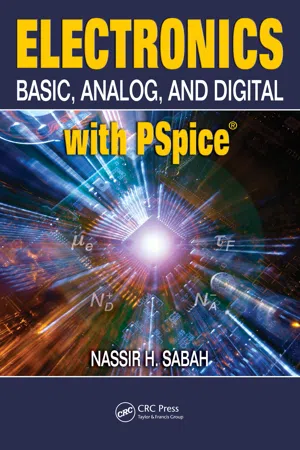
- 764 pages
- English
- ePUB (mobile friendly)
- Available on iOS & Android
About This Book
Electronics: Basic, Analog, and Digital with PSpice does more than just make unsubstantiated assertions about electronics. Compared to most current textbooks on the subject, it pays significantly more attention to essential basic electronics and the underlying theory of semiconductors.
In discussing electrical conduction in semiconductors, the author addresses the important but often ignored fundamental and unifying concept of electrochemical potential of current carriers, which is also an instructive link between semiconductor and ionic systems at a time when electrical engineering students are increasingly being exposed to biological systems.
The text presents the background and tools necessary for at least a qualitative understanding of new and projected advances in microelectronics. The author provides helpful PSpice simulations and associated procedures (based on schematic capture, and using OrCAD® 16.0 Demo software), which are available for download. These simulations are explained in considerable detail and integrated throughout the book. The book also includes practical, real-world examples, problems, and other supplementary material, which helps to demystify concepts and relations that many books usually state as facts without offering at least some plausible explanation.
With its focus on fundamental physical concepts and thorough exploration of the behavior of semiconductors, this book enables readers to better understand how electronic devices function and how they are used. The book's foreword briefly reviews the history of electronics and its impact in today's world.
***Classroom Presentations are provided on the CRC Press website. Their inclusion eliminates the need for instructors to prepare lecture notes. The files can be modified as may be desired, projected in the classroom or lecture hall, and used as a basis for discussing the course material.***
Frequently asked questions
Information
1
Basic Diode Circuits
Learning Objectives
1.1 Ideal and Practical Diodes
Ideal Diode
Table of contents
- Cover
- Half Title
- Title Page
- Copyright Page
- Dedication Page
- Brief Contents
- Table of Contents
- Preface
- Introduction
- Convention for Symbols
- Chapter 1 Basic Diode Circuits
- Chapter 2 Basic Principles of Semiconductors
- Chapter 3 pn Junction and Semiconductor Diodes
- Chapter 4 Semiconductor Fabrication
- Chapter 5 Field-Effect Transistors
- Chapter 6 Bipolar Junction Transistor
- Chapter 7 Two-Port Circuits, Amplifiers, and Feedback
- Chapter 8 Single-Stage Transistor Amplifiers
- Chapter 9 Multistage and Feedback Amplifiers
- Chapter 10 Differential and Operational Amplifiers
- Chapter 11 Power Amplifiers and Switches
- Chapter 12 Basic Elements of Digital Circuits
- Chapter 13 Digital Logic Circuit Families
- Appendix A: Reference Material
- Appendix B: Basic PSpice Models
- References and Bibliography
- Index